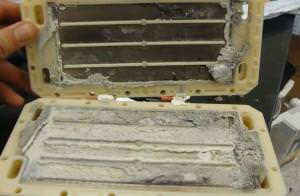Edna R.: My water ionizer has a fully automatic descaling system. Why do I have to descale it manually now?
- You have to change a baby, you have to walk a dog, you have to descale a coffee machine and a water ionizer. That's part of the system. Unfortunately, manufacturers use the term “automatic self-decalcification” very liberally. That's why I'll give you some background information: Limescale deposits in water ionizers always form on the negative pole, i.e. the cathode, which releases negatively charged electrons into the water. Positively charged calcium ions are attracted to it and then stick to the metal in increasingly thick layers. This reduces the surface area of the cathodes, so that the overall performance of the —> Electrolysis cell decreases.
- In addition, the cathode side of a diaphragm can become calcified. These deposits must be removed using decalcification systems. There are various systems on the market for this.

- Method 1: Preliminary descaling: At the start of the tap, the current is reversed for about 30 seconds. This causes the cathode to become an anode, which repels calcium due to its positive charge. During the polarity reversal, the device gives warnings that the water from the alkaline water outlet is now not drinkable. It only works perfectly in the long run if tapping water only takes 30 seconds after switching the power back. As a rule, however, the tapping takes longer, so that the cathode eventually builds up a layer of lime. Disadvantage: The user has to wait 30 seconds until he gets alkaline active water. Advantage: Warmed stagnant water from the pipe and pre-filter flows away. The average consumer would wait until the water comes out of the tap cold anyway.
- Method 2: Subsequent decalcification: After the end of the spigot, the device holds water in the electrolytic cell for a few seconds and reverses the polarity of the current as in method 1. The drain is then released via a drainage pipe to drain the acidic water. Advantage: No waiting time. Disadvantage: Only a few seconds of power reversal and lukewarm stagnant water from the pre-filter and pipe at the start of the tap. It takes time for the water to cool down, during which a layer of limescale can build up. Conclusion: Worse than method 1. But very effective when methods 1 and 2 are combined, i.e. the current is reversed before and after the tap.
- Method 3: Cyclic descaling: The current is reversed after a certain flow rate or a certain time (usually every 12 hours) for a 30-second cleaning cycle with alarm signals. Advantage: Technically simpler than method 2 and therefore cheaper. Disadvantage: Especially if smaller quantities are tapped several times a day, no descaling takes place for 12 hours, even though a large amount was produced overall. Therefore, high susceptibility to limescale and frequent manual descaling is necessary. Annoying: Even if no activated water has been produced for 12 hours, a descaling cycle with power reversal is carried out.
- Method 4: Flow Change – pole change and flow reversal: After each tap stop, the cell chamber previously used as a cathode chamber becomes the anode chamber by changing the current polarity and directing the flow to the other outlet.
This results in permanent self-decalcification. - Advantages: With smooth electrode construction (—> Electrolysis cell), this method reliably protects against calcification of the cell.
This method was patented by the Korean company Alkamedi (European brand name Aquion®). - Disadvantages: As a rule, only alkaline activated water and never acidic water flows through the upper spout. Since alkaline active water begins to relax immediately after production (—> Relaxation time), minerals are constantly deposited from the moment it leaves the cell until the outflow, which can gradually narrow the outflow.
Therefore, manual descaling is also necessary if the flow rate decreases. Just not that often.

- Method 5: Manual descaling. If the output pH value achieved has noticeably reduced with the same water flow rate or if the flow rate of the alkaline activated water has decreased compared to the sour water -
A maximum of the same amount of acidic activated water should flow out, never more than alkaline water). You have to descale manually.
Most manufacturers specify fixed intervals for certain water hardness.
Premium devices even provide automatic notifications that manual descaling is due.
Please pay attention to these instructions and do not forget to disconnect the device from the power supply.

- Please carry out manual descaling using the descaling pump supplied or available as an accessory according to the instructions.
The pump should run for at least one hour (up to 12 hours) with the descaling agent.
This must not be warmer than 35 degrees C. - If there is severe calcification - for example, if citrates (lime salts of the descaling agent citric acid) precipitate as white crystals or the descaling agent turns yellow, you should replace the descaling solution.
Please do not forget to rinse the pump thoroughly with clear water after the descaling process, otherwise it will be blocked by incrustations next time.

- A encrusted pump that won't start will usually run again if you soak it in clear water for an hour. After manual descaling, set your water ionizer to the “Purified” setting and let about 10 liters of water run through it for rinsing. This is not drinking water and may still contain residues of the descaling agent.
Excerpt from the book by Karl Heinz Asenbaum "Electro-activated water – An invention with extraordinary potential. Water ionizers from A – Z”
Copyright 2016 www.euromultimedia.de




